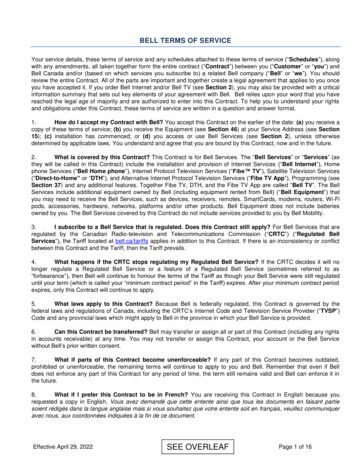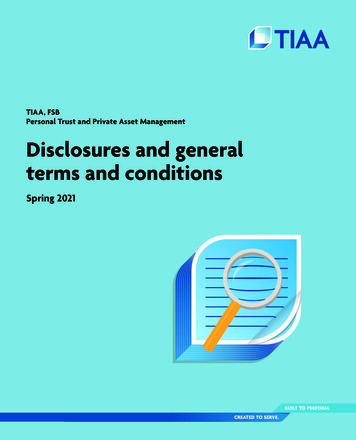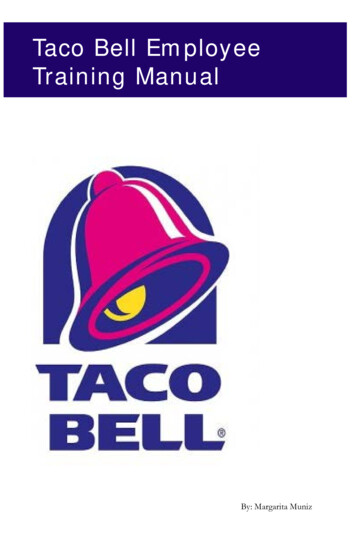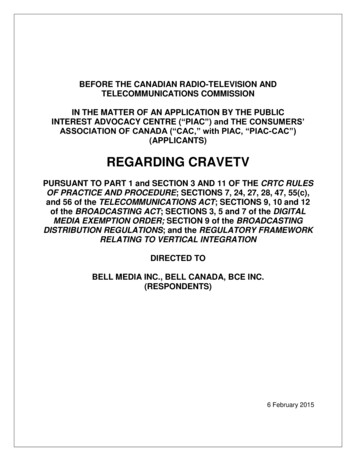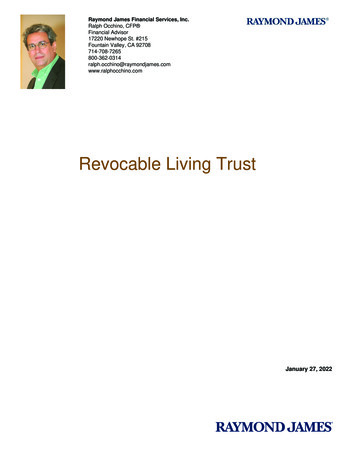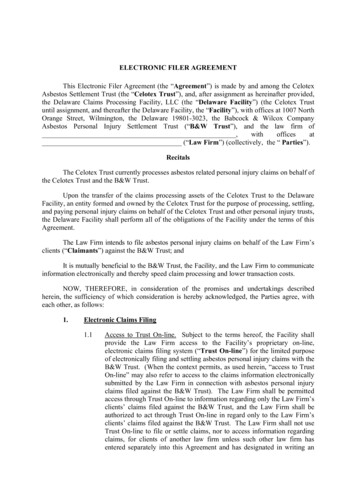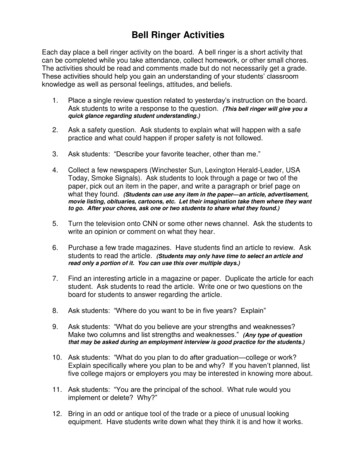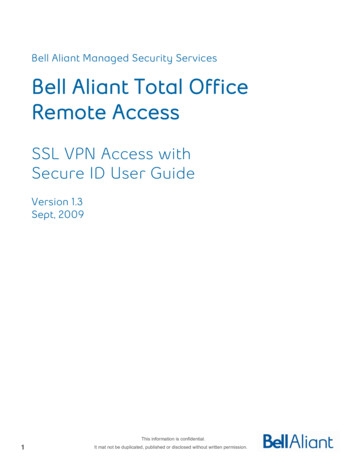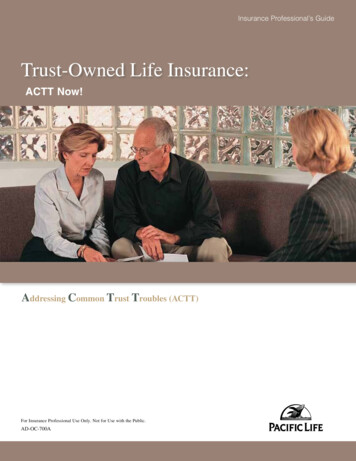
Transcription
Insurance Professional’s GuideTrust-Owned Life Insurance:ACTT Now!Addressing Common Trust Troubles (ACTT)For Insurance Professional Use Only. Not for Use with the Public.AD-OC-700A
This material is not intended to be used, nor can it be used by any taxpayer, for the purpose of avoidingU.S. federal, state or local tax penalties. This material is written to support the promotion or marketing of thetransaction(s) or matter(s) addressed by this material. Pacific Life, its distributors and their respective representativesdo not provide tax, accounting or legal advice. Any taxpayer should seek advice based on the taxpayer’s particularcircumstances from an independent tax advisor.Your client is ahead of the game when it comes to his orher estate planning. Not only has he or she made surethat a basic estate plan is in place, your client took anadditional step and used an irrevocable life insurancetrust (ILIT) to maximize the wealth transferred to his orher heirs.1 If properly drafted and administered, ILITs areexcellent estate planning tools. Proper drafting, whileundeniably important, is only one aspect of ILIT planning.One facet many people overlook is theimportance of the ILIT trustee’s role and themanagement of life insurance owned by the ILIT.Failure to properly administer an ILIT and the assetsin it (including life insurance) may subject a trustee topersonal liability. This is especially true when the ILITowns one or more life insurance policies. As a result,it is important to periodically review the life insuranceowned inside the ILIT to determine if it is still appropriategiven the circumstances. Here are a few of the morecommon trustee challenges with regards to ILIT-ownedlife insurance:Investment and Insurance Products: Not a Deposit — Not FDIC Insured — Not Insured by any Federal Government Agency —No Bank Guarantee — May Lose ValueFor Insurance Professional Use Only. Not for Use with the Public.
1. The trustee failed to review the performanceof the life insurance policy or policies.2ILIT trustees are the legal owners of life insurance policies heldin trust. As such, they owe fiduciary duties to the beneficiariesof the trust to, among other things, carry out the wishes of thegrantor as specified in the trust document and to act as a prudentinvestor would act in managing and investing trust assets.3Despite these duties, many trustees are completely unfamiliarwith life insurance and are ill prepared to evaluate and monitorthe performance of an ILIT-owned policy. Some life insurancerelated issues that trustees should continually monitor are:' Financial PerformanceHow is the life insurance policy performing?Is the performance acceptable given the circumstances?Is a different life insurance product more appropriate?Is a life insurance policy exchange necessary?' Premium Paying TechniquesIs gifting involved in paying premiums?Has the grantor used all of his or her gifting?How will premiums be paid on a going forward basis?' Risk ToleranceHas the client’s risk tolerance changed? If so, how?Does the trustee need to evaluate the type of life insurancepolicy the trust owns (i.e., cash value policies versus termcoverage)?Is a new, more or less risky product appropriate?' Adequacy of Life Insurance CoverageA client’s life insurance needs may change if his or herpersonal situation changes (i.e., marriage, divorce, morechildren, a promotion, etc.). If circumstances change or havechanged, the trustee should inquire:Does the trust have sufficient life insurance coverage toaddress the change in circumstances?Is more or less coverage needed?If more coverage is needed, does the trust havesufficient funds to make the new premium payments?Have the client’s estate tax4 needs changed? If so, doesthe existing life insurance policy address those needs?Is a loan necessary to make the premium payments?Does the life insurance policy need to be surrendered?1234In addition to maximizing the wealth transferred to heirs, ILITs are oftentimes used to address any potential estate tax liability that the grantor may face.There are circumstances in which replacing your client’s existing life insurance or annuity can benefit your client. As a general rule, however, replacement is not inyour client’s best interest. You should make a careful comparison of the costs and benefits of your client’s existing policy and the proposed policy to analyze how areplacement may affect your client’s plan of insurance. You should provide this detailed information to your client and discuss whether replacement is in your client’s best interest.In 1994, the Uniform Prudent Investor Act (UPIA) was enacted to set standards for trustees in managing and investing trust assets. The UPIA advocates the“Prudent Investor Rule” which applies modern investment practices to trust investments. It also requires the trustee to manage all assets together as a single portfolio and position the trust assets in such a way as to produce a reasonable rate of return. The UPIA encourages diversification of assets and focuses on the combinedperformance of trust assets (versus the performance of individual assets). The UPIA, or some form thereof, has been adopted in a majority of states. The UPIA setsbasic standards that may vary from state to state. Please contact an attorney in your state for more information about your state’s UPIA, if any.As of January 1, 2010, the federal estate tax is repealed until December 31, 2010. Also, over the same time period, the rules regarding step-up in basis for propertytransferred at death were replaced with a modified carryover basis at death rule. Congress continues to consider legislation that, if passed, may change currentfederal estate tax law. Please consult with your tax and legal advisors as to what effect the repeal of federal estate taxes in 2010 and their reinstatement in 2011, orany new federal estate tax legislation, may have on your estate plans.For Insurance Professional Use Only. Not for Use with the Public.one
2. The trustee failed to consult with the life insurance professional.Oftentimes, grantors appoint a family member or a trusted friendto serve as the trustee of the ILIT. These individuals are usuallyinexperienced in the “art” of trust administration and may notrealize the responsibility they have agreed to take on. Dependingon the size of the trust and the assets owned by the trust, theseduties can be rather onerous.To avoid potential liability, trustees should obtain assistance fromothers who may be more experienced with, among other things,investment and management. Most trusts are drafted so as to permitthe trustee to obtain this type of aid. It is important to review theterms of the trust to make sure the trustee has the ability to hiresomeone to help him or her manage the trust assets.5In the life insurance context, the life insurance professional canplay a vital role and become an invaluable resource to the trustee.Not only is the life insurance professional well versed in the variouslife insurance products offered or made available, he or she isalso able to provide information about, among other things:' the current coverage, including the purchase of riders tocustomize a life insurance policy for one’s individual needs;' fees, charges and expenses for life insurance coverage,including a cost of insurance based on characteristics of theinsured person such as gender, health and age;' life insurance illustrations; and,' life insurance policy review including, among other things,evaluation of: a) a policy’s features for potential adverse taxconsequences; b) product suitability given one’s risk tolerance;c) reporting of economic benefits; and, d) recording changesin policy ownership or beneficiaries.3. The trustee purchased the wrong type of life insurance policy.Occasionally, the overall concerns and goals of the client maybe overlooked in the selection of the life insurance in the policy.Alternatively, those goals and concerns may have changed overtime. Selecting a no-lapse guarantee policy just for its guaranteeor a variable universal life policy just for its upside potentialmay be overlooking the needs of the client. If a wealthy clientexpresses concern about outliving retirement assets and the trusthas some discretionary provisions that allow the trustee to lendmoney to the grantor, why have the trust own a life insurancepolicy that has little or no cash value accumulation potential?With this in mind, a trustee of an ILIT owning life insuranceneeds to carefully examine the types of life insurance policiesthe ILIT owns. Is the current life insurance type and amountappropriate for the long-term needs of the trust and the concernsof the client? If the death benefit need is significant and long-term5needs varied, does it make more sense to own a combination ofdifferent types of insurance (i.e., a no-lapse universal life andvariable universal life)? If a policy owned by the ILIT is not performing as expected, the trustee may consider if a different typeof policy (universal life, variable life, whole life, equity-indexeduniversal life, or term) is more suitable. On the other hand, the lifeinsurance policy owned by the ILIT may be performing well butthere may be a concern as to the viability or stability of the lifeinsurance carrier.All these issues should be cause for concern for the ILIT trusteewho must act in the beneficiaries’ best interest. In this type ofsituation, a life insurance professional can be invaluable becausehe or she is well versed in various types of policies available, thecarriers, the carriers rating, fund performance and other policyfeatures.Most trusts will permit the trustee to hire experts to assist them with trust administration. In fact, the UPIA specifically permits a trustee to delegate investment andmanagement functions that a trustee of comparable skills could delegate under the circumstances.twoFor Insurance Professional Use Only. Not for Use with the Public.
4. The trustee does not have sufficient funds to pay premiumson the life insurance policy.This may be a common problem that trustees of ILITs face –for one reason or another, the trustee does not have the fundsavailable to pay the life insurance premiums. Fortunately, thereare options. The trustee should try to determine if the grantorhas the ability to gift funds to the ILIT using the grantor’sannual exclusion gifting ability ( 13,000 per donee in 2010)or the grantor’s lifetime gift tax exemption amount ( 1,000,000in 2010).If gifting is not a viable option, the trustee may try to borrowmoney from either the grantor or a third-party lender. This,however, would require the trust to pay interest on the loan.Assuming the trustee chooses this option, if the grantor is able,he or she may gift the interest payments to the ILIT. This giftmay be subject to gift taxes depending on the grantor’s use ofhis or her annual gift tax exclusion amount or lifetime gift taxexemption amount. Keep in mind that with a loan arrangement,the loan must be paid back at some point.6 Assuming the lifeinsurance policy remains in force, the lender may be repaid withthe death benefit proceeds. The same is true if the lender has acollateral assignment over the cash value of the life insurancepolicy – the death benefit proceeds may be used to release thecollateral assignment.67Another option that may be available to the trustee of the ILIT isto sell other trust-owned assets (if permitted by the terms of thetrust). It is important to keep in mind that, again, the trustee owesa fiduciary duty to the trust beneficiaries to properly manage thetrust assets. If assets are sold, they should be sold for fair marketvalue. It is wise to consult with legal and financial advisors tominimize the risk of legal exposure.Additionally, the trustee may want to consider a 1035 exchange7of the old life insurance policy into a life insurance policy that ismore affordable or a paid-up policy with a reduced death benefit.If this is not a viable option, the trustee may stop paying premiumson the policy and let the policy’s cash value carry the policy.Depending on the cash value in the policy, this may only be for ashort period of time. Finally, if none of these options are viable,the trustee should consider surrendering the life insurance policyand distributing the cash value proceeds (if any) to the beneficiaries.A roll-out strategy should be considered if a loan arrangement is selected. Some possible options may be a Grantor Retained Annuity Trust (GRAT) or a sale to anintentional defective irrevocable trust (IDIT Sale).There are circumstances in which replacing your client’s existing life insurance or annuity can benefit your client. As a general rule, however, replacement is not inyour client’s best interest. You should make a careful comparison of the costs and benefits of your client’s existing policy and the proposed policy to analyze how areplacement may affect your client’s plan of insurance. You should provide this detailed information to your client and discuss whether replacement is in your client’s best interest.For Insurance Professional Use Only. Not for Use with the Public.three
5. The trustee failed to send Crummey letters.This is, by far, one of the more common mistakes that trusteesmake. By way of background, ILITs are usually funded withgifts by the grantor to the trust. Typically, these gifts involveutilizing the grantor’s gift tax annual exclusion (in 2010, 13,000per donee, per year).8 In order for the gifts to qualify for theannual gift tax exclusion they must be present interest gifts. Theproper use of Crummey withdrawal rights allow gifts to ILITs toqualify as present interest gift. This is the case because a Crummey power gives the beneficiary the right to demand that thetrustee distribute certain property to the beneficiary.9When possible, the trustee should verify that the ILIT hassufficient funds to satisfy a withdrawal right. This can generallybe accomplished by having the grantor make cash gifts to theILIT; after the expiration of the withdrawal period, the trusteecan use the gifted funds to satisfy any future Crummey withdrawalrights or pay life insurance premiums. If the trustee has a“reserve” of liquid funds in the ILIT from which he or she couldsatisfy the withdrawal right, the gift will likely still be considereda “present interest gift” even if the gifted funds are used to paypremiums immediately. If, on the other hand, the ILIT has noother funds from which it can satisfy the withdrawal right, andthe gifted funds are used to immediately pay premiums, the giftwill likely not be considered a present interest gift.108The annual gift tax exclusion is 13,000 in 2010 per donee and is indexed for inflation. The lifetime gift tax exemption amount is 1,000,000. The maximum federalgift tax rate for 2010 is 35%. Under current law, on January 1, 2011, the maximum federal gift tax rate will be 55%.9 Crummey v. Comm’r, 397 F.2d 82 (9th Cir. 1968).10 In private letter rulings, the IRS has sanctioned the use of a Crummey power to create a present interest gift even though the trust held only insurance policies withno cash value. The trust, however, must give the trustee the ability to satisfy the demand by distributing fractional interests in the life insurance policies. On trustsholding whole life polices, see Priv. Ltr. Ruls. 8044080, 8015133, 8008040. On trusts holding individual term policies, see Priv. Ltr. Ruls. 8143045, 8006109,8021059. See also Adams, “Irrevocable Life-Insurance Trust: What Are the Tax Considerations,” 120 Tr. & Est. 6 (1981); Zaritsky, Leimberg “Tax Planning WithLife Insurance,” 5.03[3][g] (2006).fourFor Insurance Professional Use Only. Not for Use with the Public.
In general, any competent adult, other than the insured(s), canserve as trustee of the ILIT.11 If the insured serves as trustee, thelife insurance policy proceeds will be includible in the insured’sgross estate3 because the insured is viewed as having incidents ofownership over the policy.12 If only one spouse is the insured13and grantor of the trust, then the non-insured spouse can be thetrustee. If the non-insured spouse acts as trustee and is also abeneficiary of the ILIT, the trust distribution provisions mustlimit distributions of trust principal to the non-insured spouse toan “ascertainable standard” (i.e., health, support, maintenance,or education14). A deviation from this language could result inthe non-insured spouse being considered to have a general powerof appointment over the entire corpus of the trust, and all thetrust assets will be includible in that spouse’s estate for estate taxpurposes.15Trustees of ILITs face many potential liabilities and challenges.These challenges include the need to properly manage trustowned assets (such as life insurance), as well as meeting theirfiduciary obligations to the beneficiaries of the ILIT. With theright tools, you, as the life insurance professional, can be a greatresource to trustees who face the daunting task of administeringan ILIT that owns life insurance.11 The trustee appointed should not be the insured or the insured’s insurance professional. An insurance professional who is paid a commission on the sale of a lifeinsurance policy represents both his or her personal interest and the interests of the trust, creating a conflict of interest.12 IRC Sec. 2042.13 With a second-to-die policy on both spouses, neither spouse should be the trustee of the trust. If either spouse is the trustee, the trust assets would be includible intheir estate.14 Treas. Reg. Sec. 20.2041-1(c)(2).15 IRC Sec. 2041(b); Treas. Reg. Sec. 20.2041-1(c)(2).For Insurance Professional Use Only. Not for Use with the Public.five
Pacific Life Insurance CompanyNewport Beach, CA(800) 800-7681 www.PacificLife.comPacific Life & Annuity CompanyNewport Beach, CA(888) 595-6996 www.PacificLifeandAnnuity.comPacific Life refers to Pacific Life Insurance Company and its affiliates, including Pacific Life & Annuity Company. Insurance products are issued byPacific Life Insurance Company in all states except New York, and in New York by Pacific Life & Annuity Company. Product availability and featuresmay vary by state. Each company is solely responsible for the financial obligations accruing under the products it issues. Product and rider guaranteesare backed by the financial strength and claims-paying ability of the issuing company.Pacific Life’s individual life insurance products are marketed exclusively through independentthird-party producers, which may include bank-affiliated entities.Please Note: This brochure is designed to provide introductory information in regard to the subject matter covered.Neither Pacific Life nor its representatives offer legal or tax advice. Consult your attorney or tax advisorfor complete up-to-date information concerning federal and state tax laws in this area.For Insurance Professional Use Only. Not for Use with the Public.AD-OC-700A15-29420-0185-29421-017/10
' life insurance illustrations; and, ' life insurance policy review including, among other things, evaluation of: a) a policy's features for potential adverse tax . of policy (universal life, variable life, whole life, equity-indexed universal life, or term) is more suitable. On the other hand, the life insurance policy owned by the ILIT .
